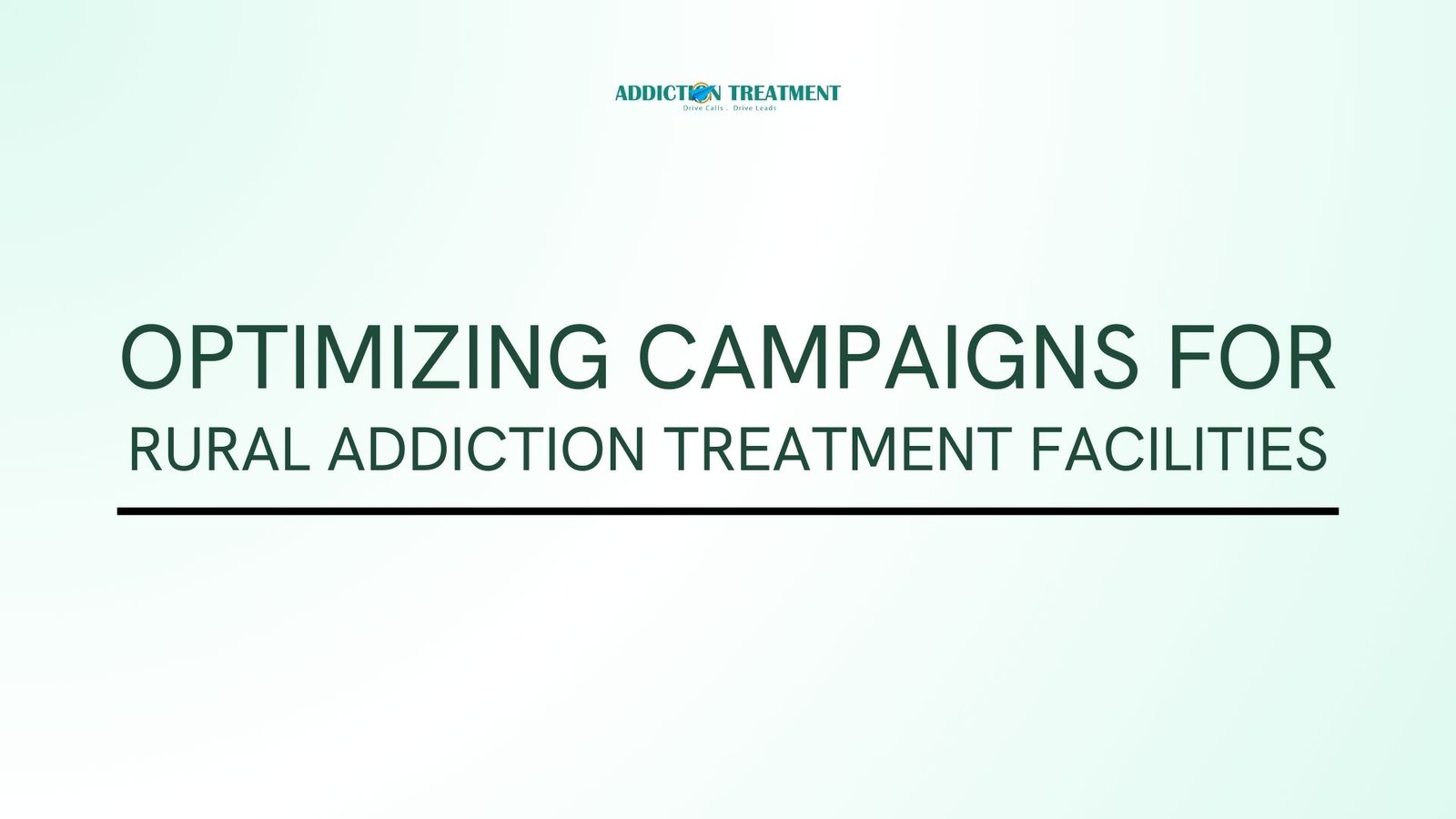Addiction treatment facilities in rural areas face unique challenges, including limited resources, geographical isolation, and difficulty reaching potential clients. However, with tailored marketing strategies and optimization techniques, these facilities can overcome barriers and effectively connect with individuals in need of help. This article explores actionable ways to optimize marketing campaigns for rural addiction treatment facilities, ensuring they maximize their reach and impact.
Why Rural Addiction Treatment Facilities Need Specialized Campaigns
Rural addiction treatment facilities often cater to underserved populations where substance use disorder is prevalent. However, traditional marketing strategies may not be as effective in these areas due to:
- Geographic Isolation: Larger distances between towns make it harder to build awareness and engagement.
- Limited Digital Connectivity: Internet access may be less reliable in rural regions, impacting the success of online campaigns.
- Stigma and Privacy Concerns: Individuals in smaller communities may hesitate to seek help due to fear of judgment.
By addressing these challenges through optimized campaigns, rural facilities can better serve their communities.
Strategies for Optimizing Campaigns for Rural Addiction Treatment Facilities
1. Leverage Local SEO
Local search engine optimization (SEO) ensures that your facility appears in search results when potential clients look for addiction treatment services nearby.
- Optimize Google My Business: Create and verify a Google My Business profile, including accurate contact information, photos, and patient reviews.
- Use Location-Specific Keywords: Target keywords like “addiction treatment center in [town/state]” or “rehab near [rural location].”
- Build Local Citations: List your facility on local directories and healthcare platforms to increase visibility.
2. Invest in Community Outreach
Building trust and relationships within the community is essential in rural areas where word-of-mouth carries significant weight.
- Host Local Events: Organize free workshops, health fairs, or informational sessions about addiction recovery.
- Collaborate with Community Leaders: Work with local influencers, religious leaders, and healthcare providers to spread awareness.
- Distribute Educational Materials: Share brochures and flyers in community centers, libraries, and clinics.
3. Use Offline Marketing Channels
Given the limited internet access in some rural areas, offline marketing methods remain highly effective.
- Radio Advertising: Radio stations often have strong reach in rural communities. Craft ads that emphasize your facility’s services and local relevance.
- Billboards and Signage: Place signs in high-traffic areas such as highways or near grocery stores to increase visibility.
- Local Newspapers: Advertise in community papers or submit educational articles to raise awareness about addiction treatment options.
4. Enhance Mobile Accessibility
While broadband internet may be scarce, many rural residents rely on mobile devices for online access.
- Mobile-Optimized Website: Ensure your website is fast, responsive, and easy to navigate on mobile devices.
- Click-to-Call Features: Make it simple for users to contact your facility directly from their phones.
- SMS Marketing: Use text message campaigns to share updates, reminders, or educational resources.
5. Utilize Geotargeting
Geotargeting helps tailor your digital campaigns to focus on specific rural areas, ensuring resources are directed toward the most relevant audiences.
- Radius Targeting: Set a defined radius around your facility to reach individuals within a manageable distance.
- Geo-Fencing: Use geo-fencing to target ads to individuals visiting nearby healthcare facilities or community centers.
- Localized Content: Create ads and landing pages tailored to the unique characteristics of the rural population you serve.
6. Address Stigma and Privacy Concerns
Stigma surrounding addiction can be particularly strong in rural communities. To overcome this:
- Emphasize Confidentiality: Highlight privacy and discretion in your marketing materials to reassure potential clients.
- Focus on Empathy: Use compassionate language that reflects an understanding of the challenges faced by individuals in rural areas.
- Promote Anonymous Resources: Provide helpline numbers or online self-assessment tools that allow individuals to seek help discreetly.
7. Build Partnerships with Local Organizations
Collaborating with local organizations can expand your facility’s reach and credibility.
- Healthcare Providers: Partner with primary care doctors, clinics, and pharmacies to refer patients in need of addiction treatment.
- Nonprofits and Support Groups: Work with organizations like AA (Alcoholics Anonymous) or NA (Narcotics Anonymous) to connect with individuals seeking help.
- Employers: Engage with local businesses to offer employee assistance programs focused on addiction recovery.
8. Share Success Stories
Success stories resonate deeply, especially in close-knit rural communities.
- Video Testimonials: Share authentic testimonials from individuals who have benefited from your facility’s services.
- Social Media Features: Highlight stories of recovery on your social media channels to inspire hope and trust.
- Community Spotlights: Celebrate milestones or recovery events to demonstrate the positive impact of your facility on the community.
9. Leverage Paid Advertising
Digital advertising platforms like Google Ads and Facebook can help rural facilities reach their target audience effectively.
- Search Ads: Target keywords like “alcohol rehab near me” or “drug detox in [location].”
- Social Media Ads: Use Facebook and Instagram’s advanced targeting features to reach individuals based on location and interests.
- Display Ads: Place banners on local websites or healthcare platforms to increase visibility.
Measuring the Success of Your Campaigns
To ensure your campaigns are driving results, track the following key metrics:
- Leads Generated: Number of inquiries or calls received from campaigns.
- Conversion Rate: Percentage of leads that turn into admissions.
- Geographic Insights: Analyze which areas are generating the most engagement and adjust your focus accordingly.
- Engagement Metrics: Monitor website traffic, ad clicks, and social media interactions to gauge audience interest.
Challenges and How to Overcome Them
1. Limited Budgets
Rural facilities often operate with smaller marketing budgets. To address this:
- Focus on high-ROI strategies like local SEO and community partnerships.
- Leverage free platforms like social media to reach your audience organically.
2. Resistance to Change
Some rural communities may be resistant to new or unfamiliar services. To build trust:
- Involve local leaders in your campaigns.
- Use educational campaigns to address misconceptions about addiction and treatment.
3. Long Travel Distances
Geographical isolation can make it difficult for individuals to access your facility. To help:
- Highlight transportation assistance options in your campaigns.
- Offer virtual consultations or telehealth services to reach clients remotely.
Future Trends for Rural Addiction Treatment Marketing
As technology and consumer behavior evolve, new trends are shaping the way rural addiction treatment facilities market their services:
- Telehealth Integration: Promoting telehealth options can bridge the gap for individuals in remote areas.
- AI-Powered Campaigns: AI tools can analyze data to optimize campaign performance and target audiences more effectively.
- Voice Search Optimization: Optimizing for voice searches like “addiction treatment near me” will become increasingly important.
Conclusion
Optimizing campaigns for rural addiction treatment facilities requires a deep understanding of the unique challenges and opportunities in these areas. By leveraging local SEO, geotargeting, community outreach, and offline marketing strategies, facilities can effectively connect with their target audience. With a focus on empathy, privacy, and tailored messaging, rural addiction treatment facilities can make a meaningful impact on their communities and help individuals take the first step toward recovery.


Leave a Reply